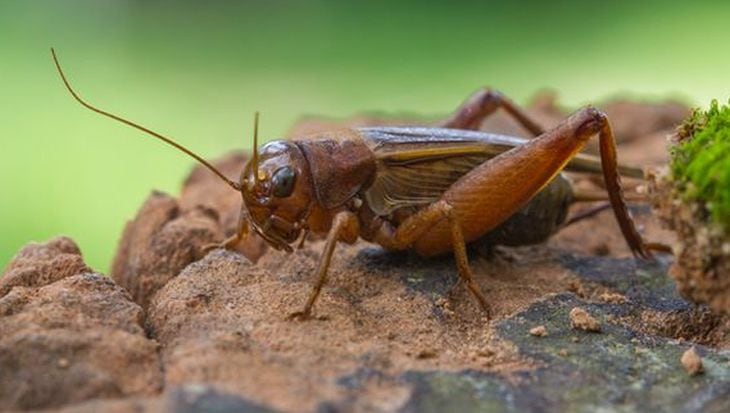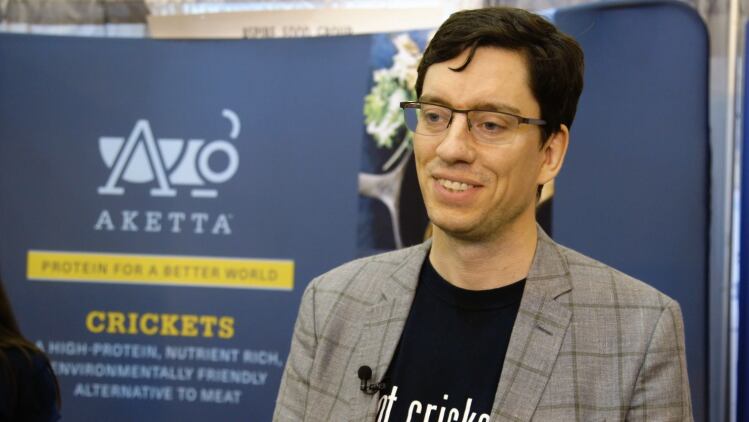If crickets – which are hugely attractive both from a nutritional and sustainability perspective – are going to carve out a meaningful space in the alternative protein arena, two things need to happen before you even start a conversation about consumer education, said COO Gabe MOtt: Costs must come down and supplies of consistent, high-quality raw materials must go up, the two motivating factors behind Aspire’s new plant.
“I'd say we could see close to an order of magnitude drop in price [once the multi-million-dollar facility is up and running] although the costs of production for any livestock operation are going up right now, from the cost of steel to freight to animal feed, and we’re all in something of a hyperinflationary cycle," he told FoodNavigator-USA.
A chicken and egg situation…
Stepping back, he said, “There’s always been this chicken and egg problem in the human food industry. No large CPG companies are going to incorporate insects because the cost is too high and the supply chain is too unpredictable, and nobody is going to invest in establishing a robust supply chain if nobody's buying it.
“We were very fortunate to find some really significant partners that were willing to commit to purchasing the majority of the production of the operation in Canada before we had even broken ground. So the bulk of it is going to a pet food company, but this will open up the human market as well.”
He added: “If you look at the companies that have failed at making those human food products [using edible insects], there’s been a host of variables, but the cost and unpredictable supply has been the real challenge.
“If you get into retail, and then all of a sudden you can’t fill the shelves, they're going to give that space to somebody else and they're not going to invite you back, so it's a precarious place to be for a CPG startup without a dedicated reliable supply chain. Once we're up and running, we'll be able to dedicate a set amount of our output to human food innovation, and entrepreneurs, and really help them getting products to market.”

The fundamentals for edible insects are strong, says Aspire Food Group COO Gabe Mott: Eating bugs is not crazy. In fact, it’s not even unusual, if you take a more global perspective, he observes, given that 2bn+ people eat insects in 80% of countries around the world, from grasshoppers and ants in Mexico to fried locusts in Thailand, caterpillars in Africa and waterbugs in China.
Cricket powder (milled whole crickets) is a whole food ingredient that's low in fat but high in protein (60-70%), calcium, iron, omega-3s, and vitamin B12.
Picture credit: GettyImages-sirichai-raksue
Farming and production now sole focus post sale of EXO brand
A pioneer in the US edible insects space, Austin, TX-based Aspire was created in 2012 by five MBA students from McGill University on a mission to drive efficiency in insect farming. Six years later, it acquired the EXO consumer brand, which makes cricket bars and high protein powders, which it recently sold to Hoppy Planet Foods so it can focus 100% of its efforts on farming and production.
Today much of Aspire's output from its Texas plant still goes into the EXO brand, but it also supplies wholesale quantities of cricket powder (finely milled whole crickets) to other human food and pet food companies, and nutrient-rich cricket frass (cricket feces, shed exoskeletons, and waste feed), which serves as an organic fertilizer, soil supplement and plant protector.
'We want to give the crickets the healthiest, lowest stress environment possible'
The Ontario plant - which received CAD $16.8m in funding from Next Generation Manufacturing Canada - will be able to produce at least 200x what Aspire is currently making in Texas, said Mott, who has spent years determining the optimal environment for producing crickets at scale, from temperature, to humidity, to the feeding regimen, to cleaning.
When it comes to raising crickets, he says, the most labor-intensive part is harvesting, “and we’ve now automated almost 100% of this.”
He explained: “You’ve got to wash everything, harvest the crickets, separate the crickets from the frass, and separate the live crickets from any dead crickets [a small percentage will die regardless of the conditions, he says, although Aspire has honed the operation such that it has dramatically reduced this percentage].
“We want to give the crickets the healthiest, lowest stress environment possible, so that means monitoring conditions at every life stage, especially the first 48 hours.”
The best environment for baby crickets
Baby crickets (also known as ‘pinheads’), for example, need moisture, but they can't have droplets of water, because they're so small that they can actually drown in them, he points out.
“There are also lot of things that pinheads can't climb, so if you leave divots or spaces they can fall into and not climb out of, they will just pile up on top of each other, so a lot of the engineering has gone into not just the design of the environment, but the materials we select and how the materials are finished, how water is provided, all of these things.
“If the feed is insufficiently fine, for example, the crickets can't eat it because they're too small.”
House crickets are gregarious, but get stressed and start eating each other if too closely packed
As for optimal densities, house crickets are “gregarious” and like to hang out with their fellow crickets, but notoriously get stressed, aggressive, and start snacking on each other if they are too closely packed, he said, so as a commercial operator, you have to find the sweet spot such that you can run an efficient farm, and the crickets have sufficient space to thrive.
“They are going to gain 800 times their weight in under a month. It’s a staggering rate of growth. They’re also climbers, so what really matters in terms of space is not volume, but surface area.”
He added: “When we started out we were searching the literature and trying to see what we could learn, and we found that the literature told us almost nothing, because it’s based on small containers, really small populations, and it just didn't translate up to larger agglomerations.
“We do a ton of monitoring at our site in Austin, Texas, and we’ve been able to learn a lot, but as we move into this large scale facility, we’re collaborating with partners including a big telecom company [TELUS Agriculture] in Canada, a sophisticated sensor manufacturer [Swiftlabs], and an AI startup [DarwinAI] to gather data on unprecedented levels, and then crunch it.”
Applying industrial automation and robotics, IoT and deep learning/analytics to farm and process crickets
Sensors designed and developed by Swiftlabs will monitor the environment, using a private industrial 5G IoT network from TELUS to provide real-time insights into conditions and plant operations, according to Aspire, which has secured a suite of patents in developing technologies for the new facility.
DarwinAI’s machine learning tool will then determine optimal light, sound, humidity, temperature, and food supplies, initially providing recommendations to plant operators, but ultimately controlling production in an automated feedback loop.
Aspire is working with several commercial partners to develop bio-based fertilizer from the cricket frass generated by the plant, while Dematic will implement an 11-story high, high-density automated storage and retrieval system.
- Checkout part I of FoodNavigator-USA's 'Edible insects in focus' series HERE and look out for part III in the coming days...

Snacks, bars and protein powders are the top application areas of interest for edible insect powders.
However, cricket powder also works well in veggie burgers, sausages, fruit rollups, shakes and other products. Inclusion rates vary by product, and are in many cases limited by cost rather than functionality, although you can generally get more in a bar, than say, chips.
As cricket powder is more like a protein powder than flour, 1:1 replacements with wheat flour are not generally advised.
Picture: Hoppy Planet Foods (which acquired EXO Protein this fall).
Feeding crickets: You are what you eat?
Aspire currently uses a modified form of organic certified poultry feed to feed its crickets, but is exploring whether it could in future incorporate a percentage of food waste streams or other more affordable/sustainable options without damaging the consistency of the final product.
The challenge – and the opportunity, says Aspire, is that crickets are the literal manifestation of the ‘you are what you eat’ axiom. In other words, if you want to produce cricket flour with a higher iron content, you can engineer that fairly easily by giving them iron-rich feed. On the downside, if you put junk in, you get junk out.
Post-consumer waste, for example, is generally too variable, which can both impact the growth rates and health of crickets and the consistency of the cricket powder they get turned into. Food waste from commercial manufacturing operations is more appealing owing to its greater consistency, although it can still present challenges, says the company.
Processing crickets
Post harvest, the house crickets [Acheta domesticus] – which are high in complete protein (65% by dry weight), iron, vitamins, and omega-3 fatty acids) are frozen, dried and sold as is, ground into powder, or ground into a slurry and spray dried (which yields a paler, finer powder suitable for more food and beverage applications, said Mott).
“We have a bunch of different approaches [to processing]. We have a patent for spray drying, and we also do a variety of different roasting and grinding approaches, depending on what the consumer is looking for.”



